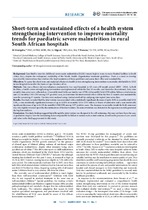| dc.contributor.author | Muzigaba, Moise | |
| dc.contributor.author | Kigozi, G. | |
| dc.contributor.author | Puoane, Thandi | |
| dc.date.accessioned | 2018-08-24T09:48:23Z | |
| dc.date.available | 2018-08-24T09:48:23Z | |
| dc.date.issued | 2017 | |
| dc.identifier.citation | Muzigaba, M. et al. (2017). Short-term and sustained effects of a health system strengthening intervention to improve mortality trends for paediatric severe malnutrition in rural South African hospitals. South African Journal of Child Health, 11(1): 38-45. | en_US |
| dc.identifier.issn | 1994-3032 | |
| dc.identifier.uri | http://dx.doi.org/10.7196/SAJCH.2017.v11i1.1201 | |
| dc.identifier.uri | http://hdl.handle.net/10566/3974 | |
| dc.description.abstract | BACKGROUND. Case fatality rates for childhood severe acute malnutrition (SAM) remain high in some resource-limited facilities in South
Africa (SA), despite the widespread availability of the World Health Organization treatment guidelines. There is a need to develop
reproducible interventions that reinforce the implementation of these guidelines and assess their effect and sustainability.
OBJECTIVES. To assess the short-term and sustained effects of a health system strengthening intervention on mortality attributable to SAM
in two hospitals located in the Eastern Cape Province of SA.
METHODS. This was a theory-driven evaluation conducted in two rural hospitals in SA over a 69-month period (2009 - 2014). In both
facilities, a health system strengthening intervention was implemented within the first 32 months, and thereafter discontinued. Sixty-nine
monthly data series were collected on: (i) monthly total SAM case fatality rate (CFR); (ii) monthly SAM CFR within 24 hours of admission;
and (iii) monthly SAM CFR among HIV-positive cases, to determine the intervention’s effect within the first 32 months and sustainability
over the remaining 37 months. The data were analysed using Linden’s method for analysing interrupted time series data.
RESULTS. The study revealed that the intervention was associated with a statistically significant decrease of up to 0.4% in monthly total SAM
CFR, a non-statistically significant decrease of up to 0.09% in monthly SAM CFR within 24 hours of admission and a non-statistically
significant decrease of up to 0.11% in monthly SAM CFR among HIV-positive cases. The decrease in mortality trends for both outcomes
was only slightly reversed upon the discontinuation of the intervention. No autocorrelation was detected in the regression models generated
during data analyses.
CONCLUSION. The study findings suggest that although the intervention was designed to be self-sustaining, this may not have been the case.
A qualitative enquiry into the moderating factors responsible for failure to sustain such an intervention, as well as the process of care, would
add value to the findings presented in this study. | en_US |
| dc.language.iso | en | en_US |
| dc.publisher | Health and Medical Publishing Group (HMPG) | en_US |
| dc.rights | This open-access article is distributed under
Creative Commons licence CC-BY-NC 4.0. | |
| dc.subject | childhood severe acute malnutrition (SAM) | en_US |
| dc.subject | Resource-limited facilities | en_US |
| dc.subject | South Africa | en_US |
| dc.subject | World Health Organization treatment guidelines | en_US |
| dc.title | Short-term and sustained effects of a health system strengthening intervention to improve mortality trends for paediatric severe malnutrition in rural South African hospitals | en_US |
| dc.type | Article | en_US |
| dc.privacy.showsubmitter | FALSE | |
| dc.status.ispeerreviewed | TRUE | |
| dc.description.accreditation | DHET | |

